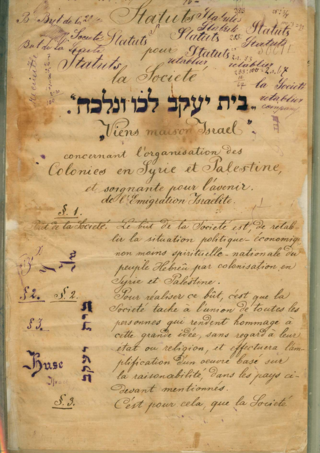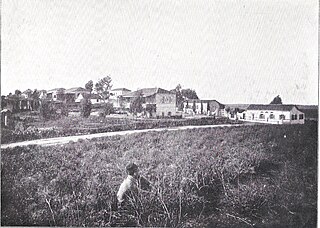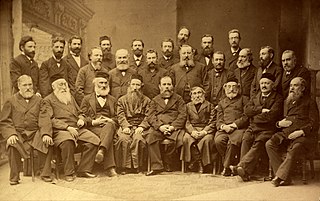This is a partial timeline of Zionism in the modern era, since the start of the 16th century.

Asher Zvi Hirsch Ginsberg, primarily known by his Hebrew name and pen name Ahad Ha'am, was a Hebrew journalist and essayist, and one of the foremost pre-state Zionist thinkers. He is known as the founder of cultural Zionism. With his vision of a Jewish "spiritual center" in Eretz Israel, his views regarding the purpose of a Jewish state contrasted with those of prominent figures within the Zionist movement such as Theodor Herzl, the founder of political Zionism. Unlike Herzl, Ahad Ha'am strived for "a Jewish state and not merely a state of Jews".

Yishuv, or HaYishuv HaIvri, or HaYishuv HaYehudi Be'Eretz Yisra'el, denote the body of Jewish residents in Palestine prior to the establishment of the State of Israel in 1948. The term came into use in the 1880s, when there were about 25,000 Jews living in that region, and continued to be used until 1948, by which time there were some 630,000 Jews there. The term is still in use to denote the pre-1948 Jewish residents in Palestine, corresponding to the southern part of Ottoman Syria until 1918, OETA South in 1917–1920, and Mandatory Palestine in 1920–1948.

Bilu was a Jewish movement of the late 19th century, fueled predominantly by the immigration of Russian Jews, whose goal was the agricultural settlement of the Land of Israel. Its members were known as Bilu'im, and the movement sought to inspire Jews to migrate to Ottoman Palestine. The Bilu'im rejected progressive notions such as Emancipation and assimilation as viable options for Jewish survival. The movement collapsed as a result of the challenging farming conditions in Palestine and a lack of funding to sustain the settlers.

Leon Pinsker was a physician and Zionist activist.
The Lovers of Zion, also Hovevei Zion or Hibbat Zion, were a variety of proto-Zionist organizations founded in 1881 in response to the Anti-Jewish pogroms in the Russian Empire and were officially constituted as a group at a conference led by Leon Pinsker in 1884.

Yehoshua Hankin was a Zionist activist who was responsible for most of the major land purchases of the Zionist Organization in Ottoman Palestine and Mandatory Palestine – in particular for the Sursock Purchase.
Palestinian Jews or Jewish Palestinians were the Jewish inhabitants of the Palestine region prior to the establishment of the State of Israel in 1948.
The First Aliyah, also known as the agriculture Aliyah, was a major wave of Jewish immigration (aliyah) to Ottoman Syria between 1881 and 1903. Jews who migrated in this wave came mostly from Eastern Europe and from Yemen, stimulated by pogroms and violence against the Jews. An estimated 25,000 Jews immigrated. Many of the European Jewish immigrants during the late 19th-early 20th century period gave up after a few months and went back to their country of origin, often suffering from hunger and disease.

Samuel Mohilever, also Shmuel Mohilever, was a rabbi, pioneer of Religious Zionism and one of the founders of the Hovevei Zion movement.

The First Zionist Congress was the inaugural congress of the Zionist Organization (ZO) held in Basel on August 29–31, 1897. Two hundred and eight delegates and 26 press correspondents attended the event. It was convened and chaired by Theodor Herzl, the founder of the modern Zionism movement. The Congress formulated a Zionist platform, known as the Basel program, and founded the Zionist Organization. It also adopted the Hatikvah as its anthem.
As an organized nationalist movement, Zionism is generally considered to have been founded by Theodor Herzl in 1897. However, the history of Zionism began earlier and is intertwined with Jewish history and Judaism. The organizations of Hovevei Zion, held as the forerunners of modern Zionist ideals, were responsible for the creation of 20 Jewish towns in Palestine between 1870 and 1897.

A moshava was a form of agricultural Jewish settlement in the Land of Israel region of former Ottoman Syria, established by the members of the Old Yishuv beginning in the late 1870s and during the first two waves of Jewish Zionist immigration – the First and Second Aliyah.
The Old Yishuv were the Jewish communities of the region of Palestine during the Ottoman period, up to the onset of Zionist aliyah and the consolidation of the New Yishuv by the end of World War I. In the late 19th century, the Old Yishuv comprised 0.3% of the world's Jews, representing 2–5% of the population of the Palestine region.

The Katowice Conference was a convention of Hovevei Zion groups from various countries held in Kattowitz, Germany in November, 1884. It was assembled to address the need of a Jewish state and to develop a plan for the creation of a Jewish state. The original date for the conference was chosen to coincide with the 100th anniversary of the birth of Moses Montefiore.

The Second World Zionist Congress met in Basel, Switzerland on 28 August 1898. and was the second meeting of the Zionist Organisation. The World Zionist Congress brought together delegates from across the world to raise funds, lobby support and create the institutions that would one day form the modern day Jewish State known as Israel, which was established in 1948. The Congress met every year from 1897 to 1901. The main focus of the Second Congress, as set out by its chair, Theodor Herzl, was to engage with Jewish communities in the diaspora and encourage them to adopt Political Zionism.

Shmuel Cohen (1870–1940) composed the music for the Israeli national anthem, the "Hatikvah" - "The Hope".

The history of the Jews in Odesa dates to 16th century. Since the modern city's founding in 1795, Odesa has been home to one of the largest population of Jews in what is today Ukraine. They comprised the largest ethno-religious group in the region throughout most of the 19th century and until the mid-20th century.

Elḥanan Leib Lewinsky was a Hebrew-language writer and Zionist leader. His book Journey to the Land of Israel in the Year [5]800 is often described as the first work of science fiction in Hebrew.













